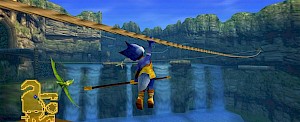Preview: Super Mario Galaxy
Posted 20 Nov 2006 at 21:49 by Conor Smyth

| "The Mario motif is a reassurance of distinguished game design from Nintendo, but what marks its importance is how it reworks conventional gameplay." |
While the other band members tune their instruments and whip up the crowd, the Wii awaits its front man. He's taking too long: they go ahead without him. The crowd cheers as the opening notes burst through the air, but they're still impatient. They'll have to wait on their star.
The Wii's current titles push forward the console in different ways, but it won't be until Super Mario Galaxy that we'll learn what a true Wii game feels like. The Twilight Princess is a Gamecube title with the Wii welded on; Wii Sports are party games at best, diversions at worst. Like Super Mario 64, Mario Galaxy is a game built from the ground up with new technology in mind. It's a demonstration of the ability to go beyond simple 'look, it's a tennis racket!' dynamics, melding the intuitive new controls with conventional game frameworks. And everyone agrees: playing it is beyond intuition.
In fact, a lot about the game is 'beyond'. 120 stars in his pocket, Mario has donned the Wing Cap, and leapt off the roof of the castle, escaping the gravity of the Mushroom Kingdom and propelling himself into space. It's new territory for the plumber, in more ways than one. The kidnapping plot remains the same, and the style of art and design in the title doesn't deviate from the sunny memories we have of the franchise, but the gameplay and level topography is new terrain. In space you run around planets - and we mean around. Gravity has been loosened, so you can run circles around smaller planets, and then leap off into the airless domain to fly to another. The standard formula of level genres is something we hope to see incorporated (it wouldn't feel like a Mario game without a lava world, would it?), but the physical dimensions of the environments have been radically changed.
The change contines: the Wiimote is used in a surprising and refreshing way. Basically, the player is control of two different characters on the screen. There's Mario, obviously, and there is a star pointer. The nunchuk controls the movement of Mario, while you use the Wiimote to, among other things, drag the pointer around and manipulate the game environment. You can freeze enemies with one hand and run rings around them with the other; you can drag objects to assault bosses. It's an understated feature with huge consequences, promising a dynamic change to how we use the environment. Platformers are defined by the relationship between the player and the environment - its most basic assumption is that you jump and run your way through them - and here we see an exciting shift in this relationship. Mario Sunshine was savaged by most, but I found in its fluid movement - the leaping, bouncing, squirting and sliding - a welcome improvement on the staticity of Mario 64 (a game with documented merit, but with a largely tempered freedom of movement). Galaxy looks to take this spirit and expand it.
It is this that marks Galaxy as something to watch. The Mario motif is a reassurance of distinguished game design from Nintendo, but what marks its importance is how it reworks conventional gameplay for new generations. Super Mario Bros. brought us platforming, Mario World 2 subverted it, Mario 64 reinvented it, Sunshine amended it... Galaxy aims to simplify it, and give the player even greater control. Perhaps more important is its potential in demonstrating how the Wii can host - and indeed, improve on - the formulas of past greats. Because Wii Sports is great fun, but we're all waiting on the frontman. He better blow us away.

























